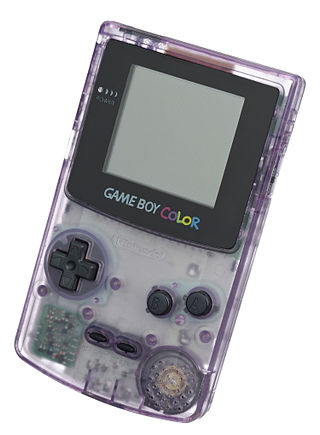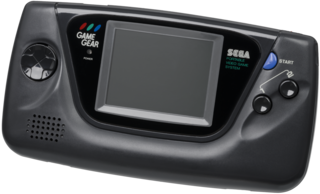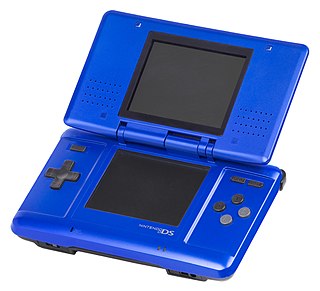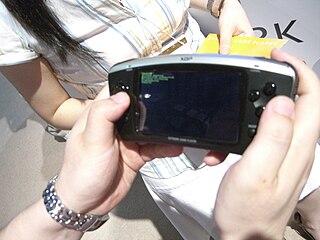
The Game Boy Advance (GBA) is a 32-bit handheld game console developed, manufactured and marketed by Nintendo as the successor to the Game Boy Color. It was released in Japan on March 21, 2001, in North America on June 11, 2001, in the PAL region on June 22, 2001, and in mainland China as iQue Game Boy Advance on June 8, 2004.

The Game.com is a fifth-generation handheld game console released by Tiger Electronics on September 12, 1997. A smaller version, the Game.com Pocket Pro, was released in mid-1999. The first version of the Game.com can be connected to a 14.4 kbit/s modem for Internet connectivity, hence its name referencing the top level domain .com. It was the first video game console to include a touchscreen and the first handheld console to include Internet connectivity.

The Game Boy Color is an 8-bit handheld game console, manufactured by Nintendo, which was released in Japan on October 21, 1998, and to international markets that November. It is the successor to the Game Boy and is part of its product line. Compared to the original, the Game Boy Color features a color TFT screen rather than monochrome, a processor that operates twice as fast, and has four times as much memory. It retains backward compatibility with games initially developed for its predecessor. However, despite these improvements, reviewers consider the Game Boy Color an evolution rather than a revolutionary leap in handheld gaming technology.

A handheld game console, or simply handheld console, is a small, portable self-contained video game console with a built-in screen, game controls and speakers. Handheld game consoles are smaller than home video game consoles and contain the console, screen, speakers, and controls in one unit, allowing players to carry them and play them at any time or place.

The Game Gear is an 8-bit fourth generation handheld game console released by Sega on October 6, 1990, in Japan, in April 1991 throughout North America and Europe, and during 1992 in Australia. The Game Gear primarily competed with Nintendo's Game Boy, the Atari Lynx, and NEC's TurboExpress. It shares much of its hardware with the Master System, and can play Master System games through the use of an adapter. Sega positioned the Game Gear, which had a full-color backlit screen with a landscape format, as a technologically superior handheld to the Game Boy.

The WonderSwan is a handheld game console released in Japan by Bandai. It was developed by Gunpei Yokoi's company Koto Laboratory and Bandai, and was the last piece of hardware Yokoi developed before his death in 1997. Released in 1999 in the sixth generation of video game consoles, the WonderSwan and its two later models, the WonderSwan Color and SwanCrystal were officially supported until being discontinued by Bandai in 2003. During its lifespan, no variation of the WonderSwan was released outside of Japan.

The Nintendo DS is a foldable handheld game console produced by Nintendo, released globally across 2004 and 2005. The DS, an initialism for "Developers' System" or "Dual Screen", introduced distinctive new features to handheld games: two LCD screens working in tandem, a built-in microphone and support for wireless connectivity. Both screens are encompassed within a clamshell design similar to the Game Boy Advance SP. The Nintendo DS also features the ability for multiple DS consoles to directly interact with each other over Wi-Fi within a short range without the need to connect to an existing wireless network. Alternatively, they could interact online using the now-defunct Nintendo Wi-Fi Connection service. Its main competitor was Sony's PlayStation Portable during the seventh generation of video game consoles.

The XGP was a concept portable video game system created by the Korean company GamePark as the follow-up to its GP32 handheld. Initially announced in 2005, the XGP was finally announced in March 2006 along with the release of the similar XGP Mini and the XGP Kids. The company went bankrupt before releasing any of the models.

The Game Boy is an 8-bit, fourth generation, handheld game console developed by Nintendo, launched in the Japanese home market on April 21, 1989, followed by North America and Europe later that year. Designed by the team behind the Game & Watch handhelds and NES games, it was Nintendo's first portable console, combining features from both.

The Japanese multinational consumer electronics company Nintendo has developed seven home video game consoles and multiple portable consoles for use with external media, as well as dedicated consoles and other hardware for their consoles. As of September 30, 2021, in addition to Nintendo Switch, Nintendo has sold over 863.07 million hardware units.

The GP2X Caanoo, more commonly known as Caanoo, stylized CAANOO, is an open source, Linux-based handheld video game console and portable media player developed by the South Korean company GamePark Holdings. It was released on August 16, 2010 in South Korea and was also sold throughout Europe. It is the successor to the GP2X Wiz, and was showcased at the Electronic Entertainment Expo 2010. The device's launch price was about US$150, which did not reach any retail stores in North America.

The Neo Geo X (NGX) is a hybrid video game console manufactured by Tommo, licensed by SNK Playmore. Information about the Neo Geo X was first reported in January 2012 and later confirmed in March. It is the first Neo Geo system to be released since the discontinuation of the brand in 2004 and the third Neo Geo handheld console, following the 1999 release of the Neo Geo Pocket Color, which was supported until 2001.

Hyperkin is an American video game peripheral manufacturer and distributor, founded in 2006, based in Los Angeles, California. They distribute accessories for major gaming consoles, in addition to creating clone consoles that play retro games with modern resolutions and on modern devices, most notably the RetroN series of clone consoles. As with most other NES clones, Hyperkin's NES clones suffer from imperfect sound due to a design flaw in the sound hardware.

The Analogue Pocket is a handheld game console designed and manufactured by Analogue. Announced in October 2019 and released on December 13, 2021, it uses field-programmable gate array (FPGA) chips to play games from various handheld consoles up to the sixth generation.

The Evercade is a handheld game console developed and manufactured by UK company Blaze Entertainment. It focuses on retrogaming with ROM cartridges that each contain a number of emulated games. Development began in 2018, and the console was released in May 2020, after a few delays. Upon its launch, the console offered 10 game cartridges with a combined total of 122 games.

Evercade VS is a video game console developed by UK company Blaze Entertainment. It is an upgraded home console version of the original Evercade handheld that introduces multiplayer functionality. It was released in December 2021 in Europe, and on 25 February 2022 in the United States.
The Retroid Pocket 2 is an Android-based handheld video game console created in China by GoRetroid and released in September 2020. An emulation console, it is capable of playing games from various handheld and non-handheld systems, including all consoles up to the Dreamcast. As the device does not accept game cartridges or discs, the user must supply a ROM image of the games they wish to play. It is the successor to the Retroid Pocket, and has emerged as a prominent handheld console for retrogaming alongside the Anbernic RG351. It is priced at US$84.99, however, a second version, the Retroid Pocket 2+, was released in early 2022, featuring a touchscreen, stronger CPU and RAM, and higher-quality buttons, at a slightly higher price point of US$99. A third version, the Retroid Pocket 2S, was released in mid 2023, featuring even stronger CPU and RAM. Critics praised its low price and build quality, but its outdated Android version, front end interface, low battery life, and offset analog sticks were noted as points of contention.
The Anbernic RG552 is a dual-boot Linux and Android-based handheld game console created in China by Anbernic. A retrogaming emulation console, it is the successor to the RG351, and is a larger console in general, about the size of a Nintendo Switch Lite. It has more powerful hardware and increased screen size in a 5:3 aspect ratio. Critics praised the system for its build quality, but criticized its price to performance ratio, saying that it would likely be eclipsed by other systems with increased emulation capabilities such as the Ayn Odin and Retroid Pocket 2+.
The Ayn Odin is an Android-based handheld video game console created in China by the company Ayn. A retrogaming emulation and mobile gaming console, it is slightly smaller than the Nintendo Switch. It was released in three models of increasing price, the Lite, Base, and Pro. The product of a successful Indiegogo campaign, it was critically praised at the time of release as one of the most powerful handheld consoles for the price, able to reliably play games from the sixth generation of home consoles. A successor, named the Ayn Odin 2 was released in fall 2023.















